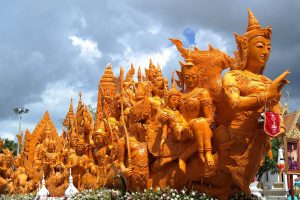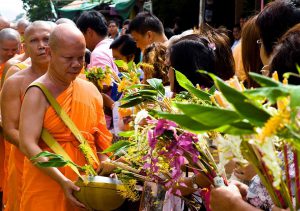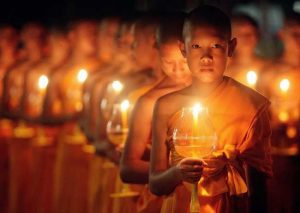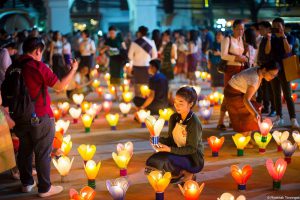Buddhist Lent in Thailand
By Dan Johnston

Buddhist Lent is upon us once again and it is the perfect opportunity to dive deeper into the culture of this bless’ed nation in which we live. Whether you are a Buddhist or not, it isn’t a case of religion, more a case of observance.
When choosing to live with people whose culture is  not native to our own, as many of us who breeze through the pages of this monthly so obviously have, it is more than just common courtesy to understand the people among who you live. One sure-fire way to get closer to a culture is to understand its history, the roots of the society, and as so often is the case, you’ll find that religion plays the pivotal role, the trunk of the tree of life if you will.
not native to our own, as many of us who breeze through the pages of this monthly so obviously have, it is more than just common courtesy to understand the people among who you live. One sure-fire way to get closer to a culture is to understand its history, the roots of the society, and as so often is the case, you’ll find that religion plays the pivotal role, the trunk of the tree of life if you will.
Thai culture revolves around Buddhism, albeit other religions are practised here and if you look further back along the historical rings of the proverbial tree, Hinduism was the mainstay for public worship. That being said, Buddhism and its practices have been influencing the culture here since as early as 250 BCE. by some accounts and became the National faith under the Sukhothai dynasty some 750 years ago.
With the patronage of the royal families, Buddhism has flushed and most of what we understand as foreigners, love and enjoy, stems around this most humble of religious practices. For example, the famed Songkran is the Buddhist New Year, Loi Krathong also derives from a Brahmanic Festival adapted by Thai Buddhist to enhance the celebrations. Buddhist Lent is no different, although celebrated across the Buddist world, throughout the Asian-Pacific and beyond, Thailand has spiced up the celebrations with a unique flavour that draws visitors from across the globe.
Such is the way of Thai people, the celebrations begin early with the procession with candles to temples across the country. Beginning as early as 5 days before the official start of lent in regions such as Ubon Ratchathani, (Isan). Their famed precession of candles, to be lit by the monks during the three months of lent, are followed by a host of celebrations including beauty pageants, candle design competitions, folk music and more, before lent begins.
Other notable celebrations include the Khao Phansa Festival in Saraburi, a vibraintly bright display of yellow and white flower offerings given to the monks as they enter lent’s trials and a merit-making ceremony held on elephant back in Surin in which the most honourable of monks ride a precision of 100 elephants to the Phaya Surin monument. Also, renowned for the folk dances of the numerous ethnic groups in the region, Suphan Buri offers a distinctive flair to their candle parade whilst the Aquatic Phansa Festival in Ayutthaya lends itself to waterways through the area, as the candles are floated to temples by the locals on colourfully decorated boats.
However, Buddhist Lent is not so much a celebration, as you might expect, but more of a time to reflect, to look inwardly and to improve oneself through awareness and abstention. Roughly translated as the Rain’s Retreat as it falls upon the start of the wet session, Khoa Phansa, the first day of the Buddhist Lent, marks the beginning of the reclusive journey for the monks vowing to stay in a single place or temple during the course of the three months. Never falling on the same day each year, due to the use of a lunar calendar, Khao Pansa fell on 17th July this year, as it proceeded the full moon during the 8th month of the said calendar.
as you might expect, but more of a time to reflect, to look inwardly and to improve oneself through awareness and abstention. Roughly translated as the Rain’s Retreat as it falls upon the start of the wet session, Khoa Phansa, the first day of the Buddhist Lent, marks the beginning of the reclusive journey for the monks vowing to stay in a single place or temple during the course of the three months. Never falling on the same day each year, due to the use of a lunar calendar, Khao Pansa fell on 17th July this year, as it proceeded the full moon during the 8th month of the said calendar.
Upon entering lent, aside from their vow to stay at a single location, the monks must practice the three key moral principles of the Dharma; to abstain from evil, perform wholesome deeds and to purify the mind. This is also true for the lay folk or common people who practice Buddhism, though the monks must take their abstention from evil to another level of intensity. Not only focusing on not doing bad but to eliminate distractions from their mind through meditations, as these are also considered an evil of sorts. The good deeds in which they are expected to perform as part of their observations of the Dharma include the teaching of the younger monks, whilst those being taught would be expected to focus on their learning, as well as working on the maintenance of their selected location and handling the daily chores, such as washing the dishes and tidying the temple area etc.
Purification of the mind is fairly self-explanatory and can be expected of both the monks and practising Buddhists alike. With the turning of lent, the common people (ie. non-monks), would be expected to give up or abstain from evil by letting go of bad habits such as alcohol and/or drugs, with many Buddhists choosing to refrain from eating meat and enjoying the sexual embrace of their partners as part of their lent.
For the average person, it is entirely up to them during lent how much are willing to give up from their daily lives, as nothing is imposed on them, such is the Buddhist way. This can be seen with recent politically backed movements over the past couple of years, asking restaurants and market stalls to remove alcohol from their shelves and off their menus. One such movement launched last year by the Bangkok Metropolitan Administration, has seen more than 2,000 officials plus staff, and students of Ramkhamhaeng University supporting the no drinking campaign during lent this year, which is a great insight into how big a role Buddhism plays in Thai Society and the seriousness of the lent celebrations.
 To take part yourself, as an expatriate living in this magical land, you could pick and choose from a host of practices expected of the everyday people around you. You don’t necessarily need to head to the temple once a week to study the Dharma, or even meditate for an hour every night before you sleep but there is no harm in stopping the flow of intoxicating beverages into your glass, or even removing the meat from your diet for a few months, as a suggestion. Can’t do you any harm after all and would only benefit your health in the long run. And if that is all a little too much, then you could just look at ways to observe a healthier lifestyle as a whole and dip into your pocket every once in a while to help the needy around you as an act of goodwill. One practice used by Thai people for this gesture is to feed the soi dogs in their area and to place spare change in the collection pots for charitable organisations.
To take part yourself, as an expatriate living in this magical land, you could pick and choose from a host of practices expected of the everyday people around you. You don’t necessarily need to head to the temple once a week to study the Dharma, or even meditate for an hour every night before you sleep but there is no harm in stopping the flow of intoxicating beverages into your glass, or even removing the meat from your diet for a few months, as a suggestion. Can’t do you any harm after all and would only benefit your health in the long run. And if that is all a little too much, then you could just look at ways to observe a healthier lifestyle as a whole and dip into your pocket every once in a while to help the needy around you as an act of goodwill. One practice used by Thai people for this gesture is to feed the soi dogs in their area and to place spare change in the collection pots for charitable organisations.
However, if you would like to feel closer to the culture, a trip to the temple during the Dharma teachings or a group meditation session wouldn’t go amiss, just ask a Thai friend (I’m sure you have one), if you can go along with them to experience the festivities more observantly. I’m certain those around you would appreciate it With many years living away from the UK in various spots across the globe, I can say from experience the people around you will see you in a better light for making an effort to understand their way of life and you’ll gain much more than just a health kick for a few months of the year also.
